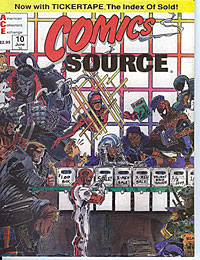Comic Book Values Part 2
In the last comic book values post we talked about the description. In this post I’ll continue with the rest of the comic book description – the grade.
What is the grade? For the new readers out there it is the condition of the comic book. Like any other collectible, the condition, or grade, is an important determinant of final value or price. In comic books just a slight increase in grade can mean literally thousands of dollars in the value.
The comic book grading scale runs from Mint down to Poor/Incomplete with several steps in between. A couple of key steps are Near Mint, which is nearly perfect in every way and Very Good, which is an average well-read comic books with several defects.
The common mistake for people new to comic books is to over grade. What I’ve noticed over the years is that many folks will tell me their comic is like new or perfect, thinking it is Near Mint. Usually, it is not. Comic book collectors are picky, and since there is so much money at stake at the higher grades, even the almost imperceptible flaw takes away from the condition. Most novice “near mints” end up being Very Fine at best.
If you are serious about learning how to grade comics, I have to recommend the Overstreet Comic Book Grading Guide.
The Grading Guide is a complete resource for beginners to serious collectors. I use it all the time to double check my grading. The guide starts with articles on the evolution of grading, how to preserve and store your comics, a very basic section about how to grade, and information on restoration.
The most important part of the grading guide is not the articles, it’s the examples. Every grade in the 10 point scale is broken down by basic description and allowable defects. The text is then followed with color photos of several comic books in each grade. The book allows you to see the differences in grades in one easily accessible place.
I do have one word of warning. Some of the pictures have defects that aren’t allowed in the grade described. An example is not allowing for any bindery tears in 9.8, but showing a book in the 9.8 section with a bindery tear. This is very important. Most of the photos are great examples, but if you see such a mistake, ignore the picture and refer to the text description of the grade. This should keep you out of trouble if you are planning on selling your comics. It does show how there is definitely a “subjective” area of comic book grading.
All points considered, I highly recommend the Overstreet Comic Book Grading Guide. It is a must have resource for novice to advanced collectors and is part of my library.
Finding Comic Book Values Part 1
If you are trying to find the value or price of a comic book there are some important items you must have. This post will discuss the first important item.
When I was purchasing large numbers of comic books I would receive many unsolicited online offers. I would typically receive an e-mail like this:
“Hey Dude,
I have some comic books that look old. Do you want to buy them. How much are they worth.”
Well, there’s not too much to follow up on when you receive that e-mail. Most people don’t write that poorly, but surprisingly enough, they won’t give you much more information than my example. The first step to find the true value of your comic books is to have an accurate description.
An accurate description of a comic book consists of three things:
- The Title with volume number if applicable
- The issue number
- The condition
An accurate description will accomplish a couple of things for you.
First, it will demonstrate to the potential buyer that you know the lingo of comic book collectors. The fact that you have at least basic knowledge of what you own will give you a better chance of not getting what I would call a rip-off offer. What I mean is this: if you write or call buyers and say “Hey, I have some old X-men will you buy them” it telegraphs that you are an amateur, and ripe for the picking. If you say “I have X-men #23-56 all in VG condition” there is a far better chance the person on the other end will assume you’ve done your research (which you have) and aren’t ready to get robbed.
Second, an accurate description will increase your chances for better offers when selling your comic books. Now this is different than the outright attempt to screw you mentioned above. Honest dealers won’t try to take advantage of you anyway. But, they don’t have time to sift through messed up descriptions in hope that you have something good. Honest dealers are usually busy, so they will probably ignore your communication. This then puts you right back into the hands of the crooks and those who don’t have the resources to give you a good price.
Let’s look at the first two items in the description, the title and issue number.
Be aware that many comic book series have been restarted several times. The are more than one series of Iron Man, Punisher and many, many others. If you get a book that says it is “Number 1”, make sure you look inside, usually on the inside cover or first “splash” page for the volume number. There is a huge difference in price between a Flash #105 1950’s series and a Flash #105 from the 1987 series. Like several thousand dollars difference. I know with that example it would seem obvious, but there are several modern series that were very close together in time, and may even be confused with a “mini-series” of four or more comics.
The issue number is self explanatory. It is difficult to mess this up and there aren’t many variations. Remember, in the end you should have something like this:
Amazing Spider-man #29
or Flash (2nd Series) #3
It may seem simple, but you would be amazed at how many times this gets messed up. Now that this step is complete it is time to get into the real work. From this point on, arriving at the correct value gets a little trickier.
Next Lesson – Grading
A Comic Book Value Website to Visit
I want to recommend a website for those of you looking for “true comic book values.” Jon R. Warren runs the I Collect Comics website and the associated “Prices Realized Database.” I don’t know Jon, but I like the product he is producing. On the Prices Realized page of his site he states:
Price Guides are opinion, Prices Realized are facts.
Now this is a guy I can agree with!
I included a little scan that will be a blast from the past for him and many collectors out there. Jon used to produce “Comics Source” magazine in the 1990’s. It followed his statement above and reported actual sales. This isn’t fluff with an agenda that is distributed by so many dealers. This is the real deal.
The only problem I had with the site is it wouldn’t allow me to become a member. When I filled out the data I received an error and I couldn’t get it to work. I attempted to input the data again, but then it told me I was already a member, but I couldn’t log in. You may have different luck, as obviously over 7,000 people have been successful. Let me know how it works for you. The members data may also be more up to date once you are inside.
I hope Jon keeps up with this effort, it’s a great resource for the comic book collecting community.
Comic Book Price Guide at I Collect Comics .com – Comic Book Collector’s Portal. Free Comic Book price guide, prices realized, image galleries, and much more.










